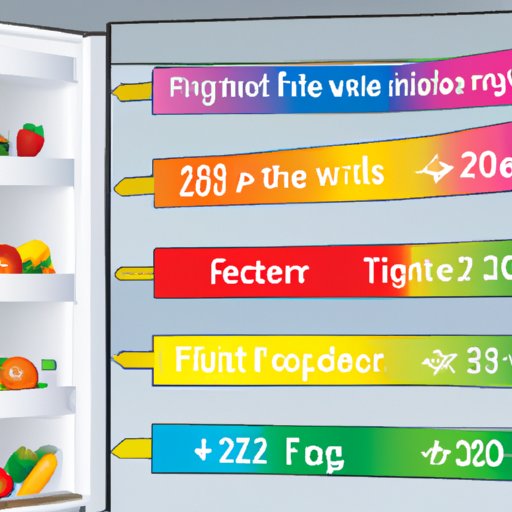Introduction
Setting the right temperature for your refrigerator is essential for maintaining its optimal performance. The correct temperature setting helps keep food safe from bacteria and other contaminants, while also ensuring maximum energy efficiency. This article provides a comprehensive guide to understanding the best temperature for your refrigerator and how to adjust it accordingly.

A Comprehensive Guide to Refrigerator Temperature Settings
It’s important to understand the basics of refrigerator temperature settings before you begin adjusting them. Knowing the ideal fridge temperature for optimal food safety and preservation will help you make an informed decision when it comes to setting your own refrigerator temperature.
The Ideal Fridge Temperature for Optimal Food Safety and Preservation
The U.S. Food and Drug Administration (FDA) recommends that refrigerators be set at or below 40°F (4°C). This temperature range is considered “safe” because it prevents the growth of harmful bacteria in food. It also helps preserve food quality and maximize shelf life.
How to Adjust Your Fridge’s Temperature for Maximum Efficiency
Most modern fridges come with a built-in temperature gauge. This device allows you to easily adjust the temperature as needed. Simply locate the gauge, which is usually located near the top of the fridge, and use the dial to adjust the temperature. For most fridges, the lower the number, the cooler the interior.
What Is the Best Temperature for Your Refrigerator?
The ideal temperature for your refrigerator depends on several factors, such as the type of food you are storing, the size of the refrigerator, and the type of energy source it uses. Generally speaking, the optimal temperature range for most refrigerators is between 35°F and 38°F (1.6°C and 3.3°C). However, if you are storing a lot of fruits, vegetables, or dairy products, you may want to set the temperature slightly lower.
The Cold Hard Facts: Choosing the Right Temperature for Your Refrigerator
When deciding on the best temperature for your refrigerator, there are a few factors to consider. First, you need to take into account the type of food you are storing. Some foods require colder temperatures than others, so you may need to adjust the temperature accordingly. Additionally, the size and energy source of the refrigerator should be taken into consideration. Larger refrigerators require more energy to maintain their temperature, while smaller ones may not need as much. Finally, the environment of the room can affect your fridge’s temperature; if the room is too hot, the refrigerator will have to work harder to keep the interior cool.
Factors to Consider
- Type of food being stored
- Size of the refrigerator
- Energy source
- Room temperature
Tips for Setting the Right Temperature
- Check the temperature regularly with a thermometer to ensure it is within the recommended range.
- Make sure to adjust the temperature accordingly if the room temperature changes.
- If possible, keep the refrigerator away from direct sunlight or heat sources.
- Keep the door closed as much as possible to prevent the temperature from fluctuating.

Refrigerator Temperature Settings: A Quick Guide for Homeowners
Adjusting your refrigerator temperature correctly is essential for ensuring optimal food safety and energy efficiency. Here are some quick tips for setting the right temperature for your refrigerator.
Benefits of Properly Setting Your Refrigerator Temperature
- Preserves food quality and extends shelf life
- Prevents the growth of harmful bacteria
- Reduces energy consumption and saves money
Steps to Follow
- Locate the temperature gauge, which is usually located near the top of the fridge.
- Use the dial to adjust the temperature as needed.
- For most fridges, the lower the number, the cooler the interior.
- Aim for a temperature range of 35°F to 38°F (1.6°C to 3.3°C).
- Check the temperature regularly with a thermometer.
Conclusion
Setting the right temperature for your refrigerator is essential for maintaining its optimal performance. An ideal temperature range of 35°F to 38°F (1.6°C to 3.3°C) is recommended for most refrigerators. To ensure maximum food safety and energy efficiency, be sure to check the temperature regularly and adjust it accordingly. Following these simple steps will help keep your refrigerator running smoothly and efficiently.
Summary of Key Points
- The ideal refrigerator temperature range is 35°F to 38°F (1.6°C to 3.3°C).
- For optimal food safety and energy efficiency, adjust the temperature as needed.
- Check the temperature regularly with a thermometer.
- Keep the door closed as much as possible to prevent the temperature from fluctuating.
Final Takeaway
By following these guidelines, you can ensure that your refrigerator is running at its peak performance. Setting the right temperature can help preserve food quality and extend shelf life, while preventing the growth of harmful bacteria. It can also reduce energy consumption and save you money in the long run.


